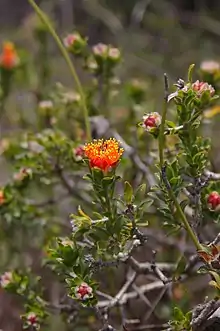Eremaea asterocarpa
Eremaea asterocarpa is a plant in the myrtle family, Myrtaceae and is endemic to the south-west of Western Australia. It is a shrub with broad, flat leaves, and orange-coloured flowers in late winter or spring. Single flowers appear on the ends of branches formed the previous year.
| Eremaea asterocarpa | |
|---|---|
 | |
| In the Perth suburb of Southern River | |
| Scientific classification | |
| Kingdom: | Plantae |
| Clade: | Tracheophytes |
| Clade: | Angiosperms |
| Clade: | Eudicots |
| Clade: | Rosids |
| Order: | Myrtales |
| Family: | Myrtaceae |
| Genus: | Eremaea |
| Species: | E. asterocarpa |
| Binomial name | |
| Eremaea asterocarpa | |
| Synonyms[1] | |
.JPG.webp)
.JPG.webp)
Description
Eremaea asterocarpa is a shrub, growing to a height of 1.3 metres (4 ft). It has a variable form, sometimes low and spreading, others erect or short and twisted. The leaves are 3.4–8.3 millimetres (0.1–0.3 in) long, 1.0–4.5 millimetres (0.04–0.2 in) wide, elliptic or egg-shaped with the narrower end towards the base and have between 5 and 7 veins visible on the lower surface.[2]
The flowers are orange-coloured, on the ends of the previous year's wood and occur singly or rarely, two together. There are 5 sepals which are densely hairy on the outside surface and 5 petals 4–6 millimetres (0.16–0.24 in) long. The stamens, which give the flower its colour, are arranged in 5 bundles, each containing 16 to 36 stamens. Flowering occurs from July to November and is followed by fruits which are woody capsules. The capsules are 6.9–8 millimetres (0.27–0.31 in) long, more or less cup-shaped, rough and lumpy with the remains of the sepals giving a star-like appearance to the end.[2] It can be distinguished from other eremaeas by the rough fruits and the presence of 5 or more veins on the leaves.
Taxonomy and naming
Eremaea asterocarpa was first formally described in 1993 by Roger Hnatiuk in Nuytsia.[2][3] The specific epithet (asterocarpa) is from the Ancient Greek ἀστήρ (astḗr) meaning "a star"[4]: 748 and καρπός (karpós) meaning "fruit",[4]: 356 referring to the star-like pattern on the end of the fruit.[2]
The names of three subspecies of Eremaea asterocarpa are accepted by the Australian Plant Census:
- Eremaea asterocarpa Hnatiuk subsp. asterocarpa[5] has leaves with 3 (rarely 5) veins;[6]
- Eremaea asterocarpa subsp. brachyclada Hnatiuk[7] is a small, low shrub with short, twisted branches and leaves with 5 to 7 or more veins;[8]
- Eremaea asterocarpa subsp. histoclada Hnatiuk[9] is an erect plant with straight or slightly arched branches and leaves with 5 to 7 or more veins.[10]
Distribution and habitat
Eremaea asterocarpa is found in near-coastal areas of the south-west in the Geraldton Sandplains, Jarrah Forest and Swan Coastal Plain biogeographic regions.[11] It grows in sand over laterite.[12]
Conservation
Eremaea asterocarpa is classified as "not threatened" by the Western Australian Government Department of Parks and Wildlife.[11]
References
- "Eremaea asterocarpa". Australian Plant Census. Retrieved 2 April 2021.
- Hnatiuk, Roger J. (1998). "A revision of the genus Eremaea (Myrtaceae)" (PDF). Nuytsia. 9 (2): 208–218. Retrieved 8 August 2015.
- "Eremaea asterocarpa". APNI. Retrieved 8 August 2015.
- Brown, Roland Wilbur (1956). The Composition of Scientific Words. Washington, D.C.: Smithsonian Institution Press.
- "Eremaea asterocarpa subsp. asterocarpa". Australian Plant Census. Retrieved 2 April 2021.
- "Eremaea.asterocarpa subsp asterocarpa". FloraBase. Western Australian Government Department of Biodiversity, Conservation and Attractions.
- "Eremaea asterocarpa subsp. brachyclada". Australian Plant Census. Retrieved 2 April 2021.
- "Eremaea.asterocarpa subsp brachyclada". FloraBase. Western Australian Government Department of Biodiversity, Conservation and Attractions.
- "Eremaea asterocarpa subsp. histoclada". Australian Plant Census. Retrieved 2 April 2021.
- "Eremaea.asterocarpa subsp histoclada". FloraBase. Western Australian Government Department of Biodiversity, Conservation and Attractions.
- "Eremaea asterocarpa". FloraBase. Retrieved 9 August 2015.
- Paczkowska, Grazyna; Chapman, Alex R. (2000). The Western Australian flora : a descriptive catalogue. Perth: Wildflower Society of Western Australia. p. 362. ISBN 0646402439.
External links
![]() Media related to Eremaea asterocarpa at Wikimedia Commons
Media related to Eremaea asterocarpa at Wikimedia Commons